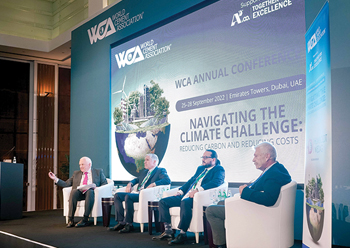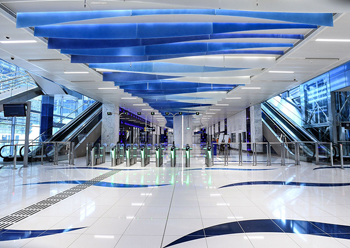
 Panellists at the WCA Annual Conference held in Dubai at the end of September.
Panellists at the WCA Annual Conference held in Dubai at the end of September.
The cement industry is notorious for carbon emissions, generating five times more carbon dioxide (CO2) than its steel counterpart. Emissions from cement producers in the Mena (Middle East and North Africa) region are currently about 35 per cent higher than the global average and yet they can reduce their CO2 emissions by up to 50 per cent through a number of measures, according to Ian Riley, the CEO of World Cement Association (WCA).
However, the cement industry in the region is simply not doing enough to reduce carbon emissions, Riley emphasises. One of the most important ways to reduce emissions is to increase the use of supplementary cementitious materials (SCM) in place of clinker or conventional cement.
Also, to encourage the industry to move towards reducing carbon emissions, governments must create incentives such as carbon pricing and green procurement for public projects while encouraging recycling of concrete waste, he says.
Excerpts of the interview:
What were the key interesting findings identified at the WCA’s annual conference in September?
The cement industry is simply not doing enough and it is clear that it should be doing much more in keeping global warming within 1.5 degrees, by meeting targets that require global greenhouse gases to reach net-zero by 2050. With materials, especially concrete, plastics, steel, glass and aluminium being responsible for 31 per cent of carbon dioxide emissions, there are a lot of things that cement companies can be doing today to not only reduce emissions but also cut costs at the same time.
Going forward, businesses have to take an integrated and holistic approach by focusing on processes including solar power, waste heat recovery (WHR) systems, sustainable biomass, use of alternative raw materials, and carbon capture, utilisation and storage, and artificial intelligence (AI).
 |
|
Riley ... cement industry is not doing enough. |
What percentage of CO2 emissions should cement producers be seeking to cut? What actions are needed by cement producers to achieve that?
Within the Mena region, cement producers are able to reduce their CO2 emissions by up to 50 per cent through several processes, including waste heat to generate electrical energy (waste heat recovery or WHR), which is a well-established technology and earns a return based on electrical power savings. However, in countries where electrical power is subsidised, such as Egypt, investing in WHR offers no return on investment.
One of the most important ways to reduce emissions is to increase the use of SCM in place of clinker or conventional cement. The most commonly used SCMs are fly ash from burning coal and blast furnace slag. Unfortunately, these materials are in short supply in the Mena region. However, there are many alternatives in abundant supply, including calcined clay and natural. Innovative technologies make both of these materials more effective than before.
Additional ways to significantly reduce emissions include substituting coal with other fuels. Many alternative fuels such as municipal and agricultural waste can be burned in cement kilns and have substantially lower carbon emissions.
How can government policy help accelerate decarbonisation?
Economic incentives are the key limiting factor, as cement generates the most carbon emissions per dollar of revenue. According to McKinsey & Company, cement generates 6.9 kg carbon dioxide per dollar in revenue, which is five times more than steel. However, governments must create incentives such as carbon pricing and green procurement for public projects, to enable change to happen faster.
Additionally, there are a number of new technologies that allow concrete waste to be processed and reused in the production of fresh concrete while also sequestering CO2. To promote the adoption of these technologies, governments should encourage circularity with specific policies favouring recycled over primary materials, whilst also playing a key role in ensuring that appropriate standards exist.
What are the good local projects or initiatives that stand out as leaders in reducing emissions in the region?
The Saudi giga projects are a chance to bring about change. They can have specific requirements for green products or they can have bidding processes that take into account the relative carbon footprint of each offer using well-established Environmental Product Declaration (EPD) life-cycle methodology. This will help start to establish a market for environment-friendly products and a practice of measuring climate impact.
Industry leader and WCA board member Dalmia Cement serves as an extraordinary example in demonstrating what can be achieved when management is aligned and determined, even in India, a country without carbon pricing. Dalmia now has the lowest emissions of any major cement company worldwide, as from June 2022 they noted 468 kg per tonne of cement.
How was the WCA’s specific Mena roadmap for cement producers in the region received and were there any specific actions/areas of improvement highlighted?
The WCA and its partner A³&Co. have developed a Mena-focused roadmap which encourages cement producers within the region to take further action in reducing their current CO2 emissions prior to governments implementing policies and legislations. The roadmap provides producers with several key steps, including operational excellence, the use of supplementary cementitious products, fuel switching to use more waste and biomass, and improving energy efficiency through WHR, cooler retrofits, process fan optimisation and much more. The conference welcomed the unique approach of the roadmap and, I believe, it will have prompted organisations to rethink their approach in addressing the urgent challenges that the industry faces.
How can decarbonisation be a competitive advantage for Mena cement producers? How can the region pioneer and motivate producers around the world to be more sustainable and innovative?
When comparing the region’s average CO2 emissions per ton of cement, the Mena region emits approximately 830 kg in comparison to the global average of 620 kg, meaning that it is currently about 35 per cent higher than the average. As a result, there is both a great need and potential for the region to decarbonise; however, we are yet to see such reductions as there has been little progress across the sector so far. The implementation of sustainable and innovative processes across cement plants requires constant investment but with a few exceptions, the investment necessary for reducing carbon emissions will be within their normal budgets. An important step is to demonstrate the benefits and outcomes of such investment through transparent reporting to the world, leading to other producers around the world implementing similar strategies.








.jpg)




.jpg)




























.jpg)



































.jpg)
.jpg)